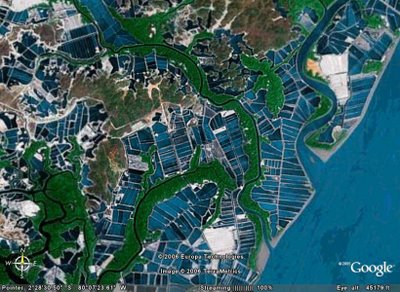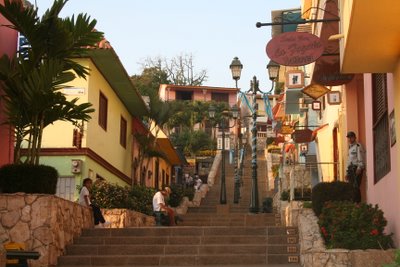 Prawns into Europe
Prawns into EuropeFeeling slightly guilty about my recent tropical weekend in Montanita, I felt obliged to bring myself back down to earth with matters related to work and to the ‘real’ reason that I came to Ecuador!
It has been a busy week in Guayaquil. This week saw AquaExpo come to town, the major annual event for those involved with the aquaculture industry in Ecuador and a great place to meet those with involvement at every level (farmer, processor, exporter, regulator). Thankfully a simultaneous translation to English was available through each of the technical presentations…a good way to learn Spanish while translating power point slides!
The picture above is taken from Google Earth (not one of mine!) and shows the extent of prawn production within the Ecuadorian coastal region south of Guayaquil. Each of the small blue blocks are the individual shrimp ponds. This is a big industry!
I think a few facts and figures that have emerged during the week are required to bring home the importance of the global tropical prawn industry. Concentrate.
1. Global production via capture and aquaculture of prawns exceeded 6 million metric tonnes (Mt) in 2005.
2. In 2005, the world aquaculture production of prawns exceded 2.5 million Mt.
3. 80% of tropical prawn culture occurs in countries considered as ’developing’ by the FAO.
4. First sale value of prawns exceeds US $9 billion per year.
5. The main prawn importing countries are USA, Japan and Europe.
6. The annual consumption of prawns in the US exceeded 2kg per capita in 2005.
7. By 2020, aquaculture will overtake capture fisheries for food fish supply.
8. The aquaculture industry requires a 3-fold expansion in the next 30 years to satisfy global demand for food.
9. The US National Institute of Fisheries (NFI) considers that the long-term future of aquatic food production lies almost solely with aquaculture (as Dr John Connelly from NFI stated ‘….we already know where every fish in the sea is and there are simply not enough to satisfy growing global demand’).
10. The European Union imported 600,000 Mt of prawns with a value of $2.3 billion in 2005.
11. Of this, approximately 140,000 Mt ($500m) were imported tropical prawns.
12. The three major buyers within the EU are Spain, Italy and the UK.
Europe does culture small quantities of ‘tropical’ prawns – around 100 Mt per annum (total value of $2m), in France (40 Mt/annum), Italy (19 Mt/annum) and Spain (44 Mt/annum).
13. In contrast, total fishery production of crustaceans from European waters totalled almost 400,000 Mt in 2004.
14. Half of all prawns produced in Ecuador are eaten by Europeans.
Ok, that will do. You get the picture.
One of the main reasons for visiting Ecuador was to familiarise myself and Cefas with an industry that is set to grow significantly in coming years. Chinese, Indian and Middle Eastern markets are at present a rapidly growing concern, with an unknown ceiling (the largest prawn farm in the world was recently opened in Saudi Arabia). Countries such as Ecuador have learnt about diseases within the industry the hard way…the slogan for the AquaExpo ‘Ecuador is Back’ reflecting their re-emergence as a global player following the devastating effect of the White Spot Syndrome Virus (WSSV) epidemic in the late 1990’s. Other countries are undergoing similar problems currently (e.g. Brazilian culture is set to drop to ¼ of 2004 values in 2006 due to a massive WSSV epidemic) .
All of these problems have major effects on the global market for food (consumers need to eat something so what do they buy instead?) and inevitably, supply problems in one industry impact upon others. Long term sustainability in production of products such as tropical prawn are now the goal. Ecuador is responding by paying much closer attention to issues such as biosecurity (i.e. the control of potential disease carriers into production systems or to the country as a whole) and it is recognised that the evident ‘gold rush’ in production in the country during the 1990’s needs to be much more carefully approached this time around.
You will be pleased to know that I have been continuing to experience the excellent seafood of South America during my stay in Guayaquil. The diet down here at the coast is quite different to that of the mountains (not a Guinea pig in sight), with fish playing a much more important role. Yesterday, I was treated to Peruvian ‘ceviche’ by Pedro Manuel Santistevan, director of CENAIC (an outgrowth of the Ministerio de Comercio Exterior). He suggested we take ‘Tigre Leche’ (‘tiger milk’) as a starter…I was happy to see that this was not some illegal aphrodisiac imported from China but instead a spicy seafood soup served in a glass with plenty of chilly (hence the tiger). Octopus ceviche followed. Great.
Tomorrow I meet the folk from the Institute Nacional de Pesca (INP) at their Guayaquil HQ. INP are the ‘competent authority’ for testing (antibiotic residues, contaminants) of Ecuadorian prawns heading for the European alimentary canal. I need to speak to them about what disease control measures are in place for similarly exported prawns.
See, I can work too!! Ciao.
Oh, and finally, here are a few shots of Las Penas (careful with the pronounciation). This is the area that I visited last week with Claudia Musello. I went up there again this evening...this time brave enough to venture alone to watch the sunset from the top of the lighthouse. Check out these shots of the city at dusk.

The glossy side of Las Penas. The area was a dangerous slum before cash for regeneration was pumped into the area by the current Mayor. The development is now being expanded to take in adjacent regions (which are still dangerous). The armed guard on the right is protecting those with expensive cameras from those at the other end of the alley.

The view from the top at sunset overlooking adjacent Cerro Santa Ana district (an area not to take an evening stroll). You don't get the impression from the image but it is still 30 degrees celcius when the sun sets!

0 Comments:
Post a Comment
<< Home